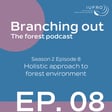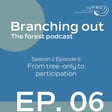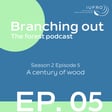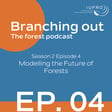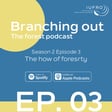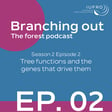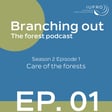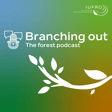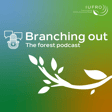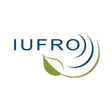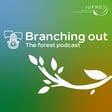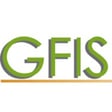Become a Creator today!Start creating today - Share your story with the world!
Start for free
00:00:00
00:00:01

Episode 7: What is a Healthy Forest?
In Episode 7, host Jose Bolaños (IUFRO HQ) and co-host Raghav Sharma from the International Forestry Students’ Association (IFSA) spoke with Tod Ramsfield (Natural Resources Canada/University of Alberta) and Maartje Klapwijk (Swedish University of Agricultural Science), Co-Coordinators of Division 7, Forest Health. They explained that their Division focuses on the interactions between trees and harmful biotic impacts, which are broadly divided into forest pathology (diseases, often caused by fungi) and forest entomology (insects).
Tune in to Branching Out: the forest podcast! Listen wherever you enjoy your podcasts, and don't forget to follow us!
Transcript
Defining a Healthy Forest
00:00:02
Speaker
What is a healthy forest? And I've always thought of it this way. a healthy forest really depends. What are your stand management objectives?
Introduction to 'Branching Out' Podcast
00:00:19
Speaker
Hello everyone! I'm your host Jose Bolaños from the International Union of Forest Research Organizations, IUFRO, the global network for forest science collaboration. And you're listening to season two of Branching Out, the forest podcast.
00:00:32
Speaker
It's great to have you with us as we explore more forest science.
Meet the Guests: Margie Kladwick and Todd Ransfield
00:00:35
Speaker
This is episode seven and we've covered IUFRO scientific divisions one, two, three, four, five and six. And we have with us today, Margie Kladwick,
00:00:45
Speaker
and Todd Ransfield, co-coordinators of Division 7 Forest Health. But before we begin, i would like to present my co-host Raghav from the International Forestry Students Association, IFSA.
00:00:57
Speaker
Could you please introduce yourself and tell us what and where are you currently studying?
Raghav's Background and Role
00:01:02
Speaker
Hello everyone. Thank you so much, Azay, for having me here today at this part of the podcast. My name is Raghav. I am currently the Head of Subcommissions for Forest Europe from IFSA.
00:01:11
Speaker
Forest Europe is a high-level policy forest policy platform and i act a liaison between the International Forestry Children's Association and Forest Europe. I'm currently finishing my master's with the Mediterranean Forestry Erasmus Mundus program and I'm currently finishing my thesis in University of Padova but at the same time I recently started working as a forest policy communicator with ah European Forest Institute here in Bonn.
00:01:36
Speaker
Well, welcome to Branching Out and now our guests, could you please introduce yourselves and your roles? Thank you Jose for the introduction and Ragoff as well, nice to meet you. So my name is Todd Ramsfield, i am a research scientist with the Canadian Forest Service. My area of expertise is forest pathology and I'm based here in Edmonton, Alberta.
00:01:57
Speaker
Thank you, José. My name is Maritja Klapveik. I am a forest entomologist based in Sweden. work at the university of of the Swedish University for Agricultural Sciences, where I am an associate professor.
00:02:14
Speaker
Welcome to the two of you. Maybe Raghav, do you want to kick it off? Thank you so much to both of our hosts over here for your introduction. So we'll shoot out with some questions. ah So as we have been explaining throughout the season of podcast, IEOFRO's scientific activities are organized in various divisions. Now, could you tell us more about Division 7, Forest Health and its primary focuses?
Focus on Division 7: Forest Health
00:02:37
Speaker
The Division 7 is the division focusing on forest health, which means that we are engaging researchers that are looking at physiological and genetic interactions between trees and harmful biotic impacts. That also involves resistance mechanisms, biological and applied aspects of tree diseases, environment, pathogen interactions, forest decline, forest mortality.
00:03:01
Speaker
and the biology and control forest insects. That is what we do. we have a whole bunch of research groups and research groups coordinators that are specialists in these subjects.
00:03:12
Speaker
I can add to that. There are two research groups. The first one, 7.02, is forest pathology. And within that research group, there are 11 working parties. And they basically, ah the researches in these working parties focus on different aspects of tree health, whether it's stem and root diseases or, say vascular wilts, that sort of thing. So basically, all parts of the tree looking at different pathogens that affect them.
00:03:37
Speaker
And then the research group 7.03 has got its forest entomology and there are, I believe, 14 working parties within that research group. And as Marc just said, they study all different aspects of forest entomology. And there are some research groups that do overlap between forest pathology and forest entomology, such as social aspects of forest health or alien invasive species in international trade,
Forest Pathology and Entomology: What's the Difference?
00:04:02
Speaker
that sort of thing.
00:04:02
Speaker
How will you explain the difference between one another In principle, they are the same thing because both they are organic, they're organisms affecting tree. The tree, tree growth, tree living.
00:04:15
Speaker
But the pathology side, mostly based on forest diseases and the entomology side is based on insects that feed on the trees. And I mean, both organisms live on the trees and need the trees to live.
00:04:30
Speaker
but they are extremely different in how they use the tree. Yes, so forest pathogens are typically fungi that are able to infect the tree, whether it's the roots, the stems, or the leaves.
00:04:44
Speaker
And through their infection, they can cause disease, which means it disrupts the normal functioning of the host tissue. and as a result of causing the disease, affects the growth of the tree. It can affect the wood quality, it can cause mortality, it can just slow down growth.
What Makes a Forest Healthy?
00:05:01
Speaker
So yeah, forest pathogens are typically fungi that cause forest diseases. So a good example of some invasive forest pathogens would be Crartian rubicola, the causal agent of white pine blister rust, which was something that was introduced into North America in the early nineteen hundreds What is a healthy forest? And I've always thought of it this way. a healthy forest really depends.
00:05:25
Speaker
What are your stand management objectives? So if you are growing a stand of trees in order to generate wood products, such as lumber, then any sort of agent that comes along and affects the quality of those trees is going to cause a decrease in forest health. So whether it's a pathogen that's causing a defect in the tree or insects that are killing the trees,
00:05:48
Speaker
In those cases, in stands managed for forest and timber production, disease and insect would be considered negative. But if you have a native forest and a native pathogen in an area such as a park that's set aside for you know biodiversity and whatnot, then these agents that cause disease or cause mortality can actually be viewed as a good thing because they're causing the ecosystem to change. They're resetting the ecosystem, providing biodiversity,
00:06:16
Speaker
One of the things that forest pathogens do is they cause trees to die, ultimately, but then when the trees die, they become decayed and the nutrients are returned into the ecosystem. So, depending on why these the stand of trees is planted and growing, you may have a different aspect on what a a healthy forest actually is.
00:06:35
Speaker
I'm very fascinated by the concept of forest health because it is indeed, as Todd says, it's a little bit in the eye of the beholder. And if you look at it from an ecological perspective, and then basically forest health is a forest that has ah certain maintenance of natural functions, providing ecosystem services, but also is resistant or resilient, even though I don't really like the the word resilient so much in this context.
00:07:02
Speaker
to disturbances. you can also think about forest health, for example, when Todd talks about instead of having monoculture plantations to introduce a mixture or uneven aged forest forestry, to try and increase the diversity, the structural diversity and the tree diversity in the stand, because that will in the end have feedback.
00:07:26
Speaker
on for example, understory diversity, microclimate, and that will affect how insects and and also pathogens, how well they will do in in that stand. And for insects, we know that they ah they are often active searchers. So if you dilute the research that they're looking for, it becomes harder for them to search for pathogens. It's probably more of a chance process.
00:07:49
Speaker
By mixing forest, you can confuse the insects and in that way you make the risk of high damages lower because many of the insects at the moment that we have in the Northern Hemisphere that cause pest outbreaks, they are very specialistic.
00:08:04
Speaker
But there are also other species that, for example, if you think about spongy moth in the US, which is an invasive species in the US, which is highly polyphagous, so eats a lot of different species of trees, then mixing is probably not the best way of managing a species like that. So Todd, you explained it strictly depends, your measurements, depending on what your goal is. So if it's like production of timber, then your goals are separate, whereas on the ecological perspective, your goals are separate.
00:08:33
Speaker
But just for example, like if there's an ecological goal to keep the area as it is, and we know it is affected by a pathogen, but that pathogen happens to be an alien species.
Managing Invasive Pathogens
00:08:44
Speaker
So how do you get by it or get around it?
00:08:47
Speaker
This is a real problem. So I can think about here in Canada, and we have high elevation whitebark pine and limber pine. These are tremendously long-lived and charismatic species that are affected by white pine blister rust, which is an invasive species.
00:09:04
Speaker
So there are two other species, Western and Eastern white pine, that are also affected by that disease, and they're commercial species. But as a result of this invasive pathogen, a lot of work has been done, particularly by our colleagues in the US Forest Service and the Canadian Forest Service, to look at resistance mechanisms.
00:09:24
Speaker
for this exotic, against this exotic pathogen, Karashina rubicula. So actually this works well with a recent meeting that was just hosted by one of our Iufro Division 7 and Division 2 working parties that got together to look at resistance mechanisms in five-needle pines.
00:09:43
Speaker
So generating resistance by essentially going out into the field, looking in areas where the pathogen is present but there are healthy trees, taking seeds from those healthy trees and then screening them to see if they are resistant in the laboratory to the pathogen, you can start to generate populations that may be resistant.
00:10:03
Speaker
And then if you have that resistant material, then you can start to use that in the areas where the pathogen is causing problems and hopefully over time will improve the resistance on the landscape to that pathogen. So yes, exotic pathogens causing problems in native forests that we're trying to preserve are real problem.
00:10:24
Speaker
It's very difficult in the native forests to influence the activity of native insects and pathogens. You can do things by manipulating how you actually plant the trees in the first place. You can put mixtures of species in, or you can do some things in your site preparation to try and prevent, say, root disease from coming and affecting the trees.
00:10:46
Speaker
But in a case of like, say an exotic southern hemisphere plantation where they're growing Pinus radiata, which is an exotic species, and there's no pathogens or insects in the area that affect Pinus radiata, the best thing you can do is try to keep them out of the country in the first place.
00:11:03
Speaker
I remember from the last season, so Andrew Liebhold was with us on this podcast, and he told us that the two largest problems globally these days are climate change and biological invasions.
Threats to Forest Health: Climate Change and Invasive Species
00:11:16
Speaker
Do you stand by this statement? And could you explain how this is worsening the health of our forests? Sure. So I'll start maybe. I fully agree with what Sandy had to say. The two largest challenges that we are facing right now are climate change and invasive species.
00:11:32
Speaker
ah With climate change, as we all know climate change is causing changes in weather patterns. and particularly forest pathogens really cue off of weather, and weather is important for the infection process and whatnot. So when those weather patterns change, we have changes in the biology and how the pathogens interact with their host.
00:11:55
Speaker
So over time, we see changes in how these things are interacting with one another. We can also see how ranges change between forest pathogens and their hosts. There might be areas that become susceptible because the weather and climate have become suitable for that pathogen.
00:12:12
Speaker
And we also can't forget how important stress is when climate changes things like drought, stress trees. On one hand, stress trees are less able to respond to pathogens, but also in and of itself, drought and water stress is something that causes mortality. So yeah, climate change is a big one for sure.
00:12:33
Speaker
Maybe Marcia wants to talk about invasive alien species. Yes, for me actually those two things also hang together. Changes in climate make certain areas more susceptible for establishment of invasive species.
00:12:46
Speaker
and We can see for example in Sweden that the weather has become much more benign. The winters have become warmer and that's for the whole of Northern Europe. Which makes it easier for species from other parts of the world that maybe are not that weren't so harsh to come and establish in regions that have a changed climate.
00:13:04
Speaker
together with the combination of increased trade and different trade routes as well. And so there's a lot of wood and wood products being moved and plants and life plants being moved between countries and between continents.
00:13:18
Speaker
Then at the same time, there's also a lot of wood packaging material that ah can also contain species. There are rules and regulations to prevent this, but yeah, the amounts that are moved around are so large.
00:13:31
Speaker
that this intercepting species that come in and could potentially be harmful is a very big task at the moment. When we talk about invasions, we often talk about two different aspects.
00:13:44
Speaker
it's One is from an invading species perspective, we talk about invasiveness. Are there traits in a species that makes that species, an insect or a pathogen, a better invader than other species from the same origin?
00:13:59
Speaker
So how but what kind of species traits make them actually ah successful in establishing in a new in a new area? Then the other part is um the invisibility.
00:14:11
Speaker
And there biodiversity and diversity per se comes in at play because then you have and the idea that if you have a ah diverse environment that should in principle lead to a lower invisibility.
00:14:27
Speaker
But many ah species, they use a limited resource range, say. So you have three species, three families, And if you have a lot of that in certain areas, like mixed in areas, then it is the same as with trying to make a more healthy forest against the native pests.
00:14:48
Speaker
If you have increased diversity, you will have a lower chance of species being able to establish. And that is an interaction between the invasiveness of the species and the invisibility of the area where they arrive.
00:15:03
Speaker
Once an invasive species is in an area, it's either it's managing to move by itself, but it also takes a lot of lifts from cars. And we also transport a lot of by moving wood around, for example. If you have if you think about firewood and you have a summer cabin and for some reason you decide to cut a tree at the place where you live and you transport it several hours over to your summer house,
00:15:33
Speaker
you might have already been one of the vectors of ah of spread. Is there any specific issue right now on the tropics or even south from the tropics that it's current, like a pathogen or an insect that is attacking the forests?
Challenges in Legislation for Alien Species
00:15:48
Speaker
An interesting example of this, Jose, is guava rust, which is a pathogen that affects eucalyptus. And there's a bit of an interesting story here in that this pathogen is present and native in Brazil.
00:16:01
Speaker
And eucalyptus plantations were established in Brazil a while ago. And what this eucalyptus was growing there it became attacked by the guava rust.
00:16:14
Speaker
So eucalyptus is not native to Brazil. But moving eucalyptus to Brazil provided an opportunity for this native pathogen to jump onto an exotic coast.
00:16:26
Speaker
And now we've seen that this pathogen has actually moved through Hawaii, back to Australia, where it's affecting basically plants in the eucalyptus family in Australia, and it's also carried across to New Zealand, where it's affecting some native plants in New Zealand.
00:16:46
Speaker
So it's an unfortunate example of how moving plants around resulted in introducing a pathogen and a host, and then the pathogen making its way back to the native range of the host.
00:17:02
Speaker
As all of the divisions at IU Faro has been very active hosting numerous webinars and meetings, could you maybe highlight some of the recent scientific developments? So in Europe, they have legislation for carrying pests where it's already determined. Like if you have a species in your country, like there's a certain amount of steps you need to take to try and eradicate the species.
00:17:25
Speaker
But there's also a list of alien invasive species and those are not pests, but they are ecologically actually extremely damaging, but there is not the same type of legislation attached to them.
00:17:36
Speaker
So there is still, like you have extremely difficult ecological species that can outcompete many native species, but that are, ah that do not follow the same legislation as, for example, economic, potential economic pests.
00:17:53
Speaker
So that makes the whole problem rather big, I think. I really like that you introduced that actually, because you can see that it's not only a scientific issue, but it's obviously it has legislation on the one side. There's also the social aspect of it.
00:18:07
Speaker
The newer work of the division has been focusing on invasive species. We've had um a task force on this subject. We are also working towards understanding why certain, that's the social part of our division, is understanding why it is so hard to change things.
00:18:26
Speaker
Why is it so hard to get legislation in? What are the attitudes of people? so And that, I think, is a rather new development that within the natural sciences, within our field of research in forest health, more and more we start to understand, okay, that we can provide a lot of information, that information also needs to be applied. Maybe Todd can say something about the movement in pathogen research.
00:18:52
Speaker
think I wanted to highlight the work that one of our deputies in research group 7.03, Josephine Koefflek, led, which was a webinar series to celebrate the International Day of Women and Girls in Science.
00:19:09
Speaker
So in 2024 2025,
00:19:12
Speaker
She prepared a group of women to basically provide three webinars over 24 hours in which they were all able to explain their research and really highlight the the work that's done by these women across all you know all continents, all related
Celebrating Women in Forest Science
00:19:33
Speaker
to Forest Health. And it was a really an exciting opportunity to hear the work that these women were doing. So it was really nice of Josephine to prepare that.
00:19:42
Speaker
I believe it is on YouTube. Looking ahead, what are some of the upcoming key events or areas of focus for your current division?
Importance of Student Involvement in IUFRO
00:19:51
Speaker
so There's quite a few meetings that are planned over 2025 and 2026. I would basically encourage people to that are interested to for the details to look at the IUFRO website because the most accurate information is there.
00:20:06
Speaker
In May, the vascular wilt group and the pine wilt disease group are meeting in Athens. And then in July of 2026, there's several entomology working groups, primary working parties, were meeting in Fredericton.
00:20:22
Speaker
And September of 2026, the FITOP through a working group party is meeting in the Cape region of South Africa. the Root and Stem Rot group is planning to meet in Mexico in November of 2026.
00:20:37
Speaker
So there's there's lots of meetings and lots of opportunity for people to become involved. And then in 2027, we're planning to have an all-Division 7 meeting in Edmonton, Alberta in August of 2027.
00:20:50
Speaker
if you're interested, and go to the IUFRO website, because the working party meetings, they are often extremely rewarding for exchange of information and for starting collaborations.
00:21:02
Speaker
I'm just i was really encouraged that Raghav is representing the IFSA because we would really love to encourage students to become involved with IUFRO. The opportunities are there and you know you don't have to be shy just come to a meeting talk your supervisor into sending you to a meeting to present your research and by doing that you'll be able to interact and meet with you know researchers and grow your own network which is really an important part of you know as your career starts.
00:21:32
Speaker
I would say the work it starts with the working party meetings because there are small people who are really interested and the atmosphere is often very welcoming and egalitarian as well.
Insights and Challenges in Forest Health
00:21:43
Speaker
So I'll throw it back to you, Raghav, and I want to know you know which key takeaways you have for today. Thank you so much. Thank you so much, first of all, for having me here in the podcast. This in itself shows like a really good initiative from IUFARO, including students, into scientific sphere.
00:21:59
Speaker
And thank you so much for your contributions today. It was, I actually, amm I'm not a pathologist, I'm not an entomologist by my background, but I did take one course by Dr. Antre Battisti in University of Padua. Maybe some of you might know him. Really, really great guy. And we did visit the VIA storm affected areas in Italy and did see what Bart Beetle has done over there and that was like actually eye-opening for me and today was just even more eye-opening other than that and specifically what Marci said about like we do know that there are pathogens and insects being transported around the world when we transport plants and stuff but I wasn't sure or I didn't even know that
00:22:39
Speaker
They are also being packaged with the packaging box as Europe is moving more towards a bioeconomy and there's a drive towards making things more sustainable and then you're using these products. But they can, at the hindsight, also be carriers of these pests and diseases, which was something that I never even thought about. So thank you so much.
00:22:58
Speaker
So with that, I'd like to thank our guests here today.
Conclusion and Social Media Engagement
00:23:01
Speaker
Thanks to Margie, to Raghav, to Todd, and thank you to our listeners. We are almost at the end of this season, so look out for our next Branching Outers episode where we'll explore Division 8 of A Euphro. And if you want to know more about A Euphro, follow us on social media or click on the link on the show notes.
00:23:21
Speaker
Thank you and goodbye.
